Abstract
To determine risk factors for cholera in an epidemic-disease area in South America, a case—control investigation was performed in Guayaquil, Ecuador, in July 1991. Residents > 5 years old who were hospitalized for treatment of acute, watery diarrhoea and two matched controls for each were interviewed regarding sources of water and food, and eating, drinking, and hygienic habits. Interviewers inspected homes of case-patients and controls to document water treatment, food-handling, and hygienic practices. Faecal specimens and shellfish were cultured for Vibrio cholerae O 1. Isolates were tested for susceptibility to a variety of antimicrobial agents. Drinking unboiled water (odds ratio [OR] = 4·0, confidence interval [CI] = 1·8—7·5), drinking a beverage from a street vendor (OR = 2·8, CI = 1·3—5·9), eating raw seafood (OR = 3·4, CI = 1·4—11·5), and eating cooked crab (OR = 5·1, CI = 1·4—19·2) were associated with illness. Always boiling drinking water at home (OR = 0·5, CI = 0·2—0·9) was protective against illness. The presence of soap in either the kitchen (OR = 0·3, CI = 0·2—0·8) or bathroom (OR = 0·4, CI = 0·2—0·9) at home was also protective. V. cholerae O 1 was recovered from a pooled sample of a bivalve mollusc and from 68% of stool samples from case-patients. Thirty-six percent of the isolates from stool specimens were resistant to multiple antimicrobial agents. Specific prevention measures may prevent transmission through these vehicles in the future. The appearance of antimicrobial resistance suggests the need for changes in current methods of prevention and treatment.
Full text
PDF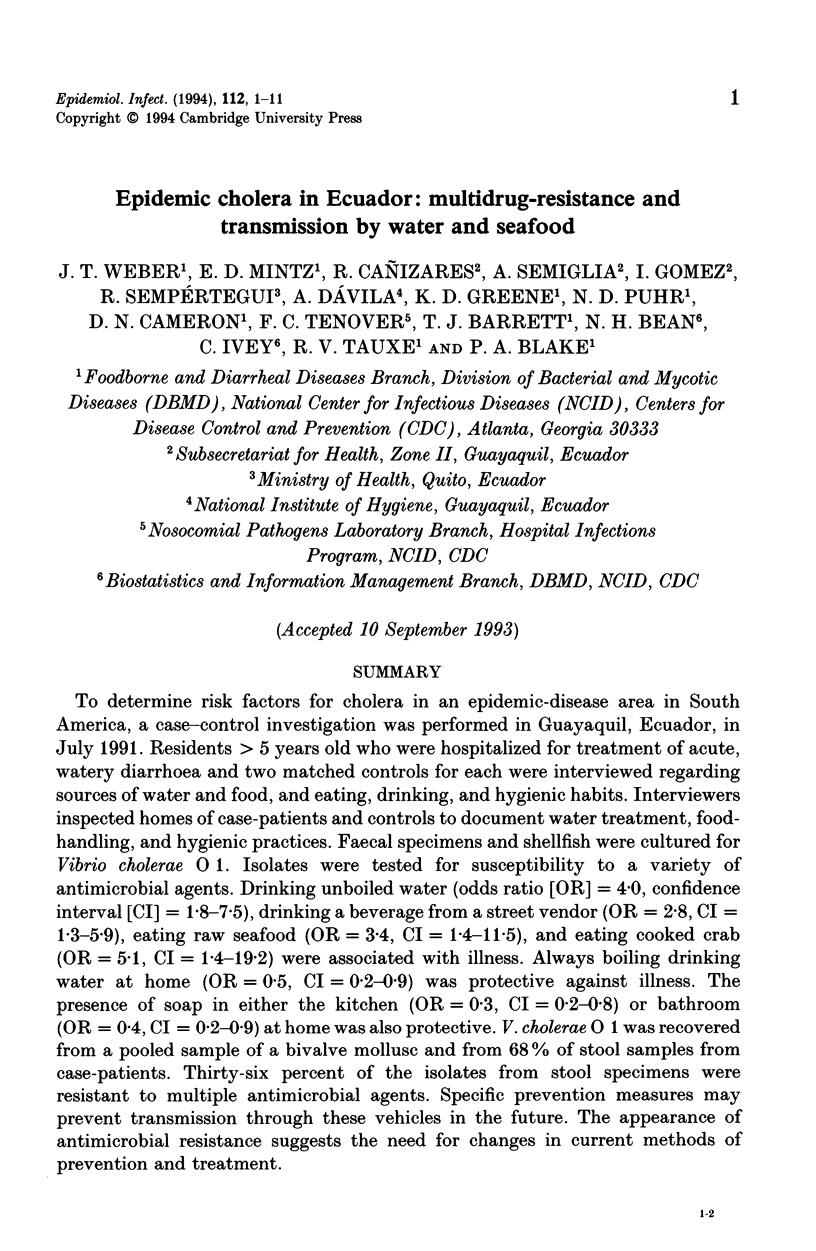
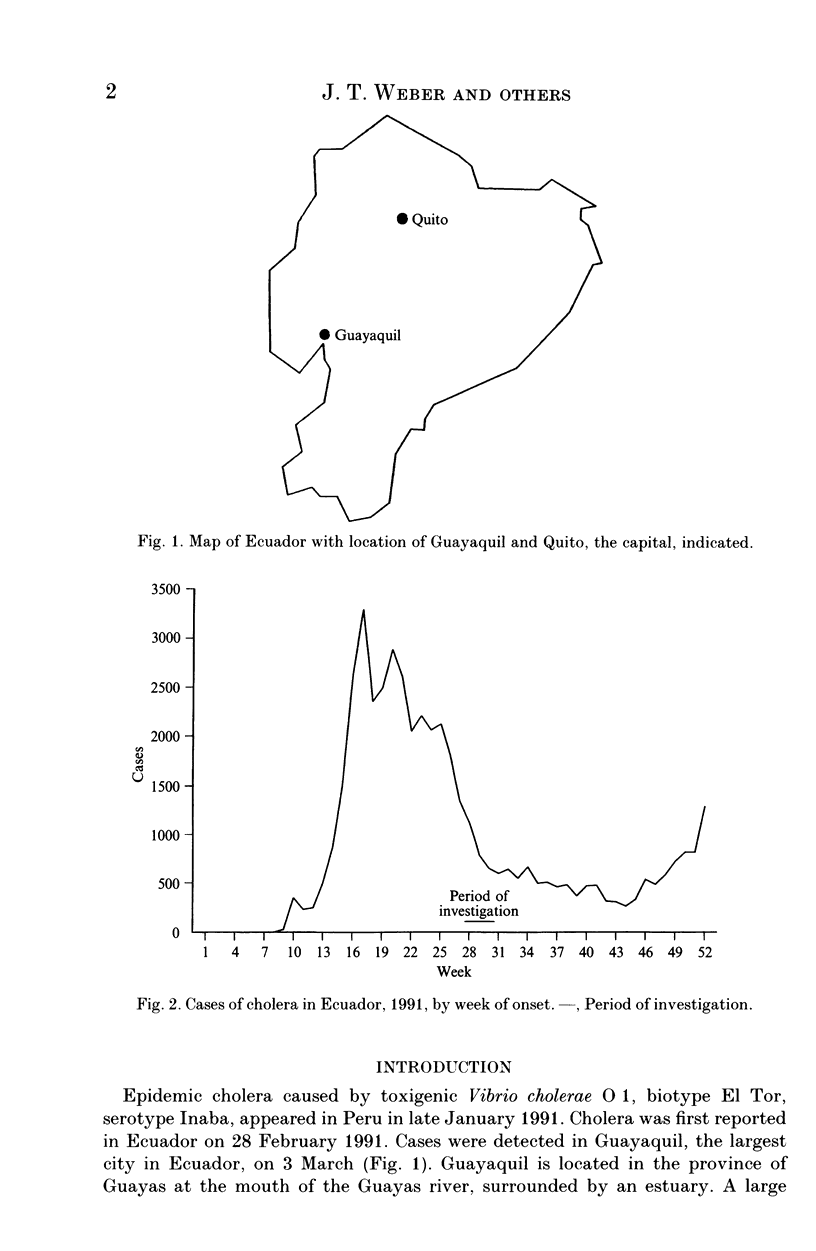
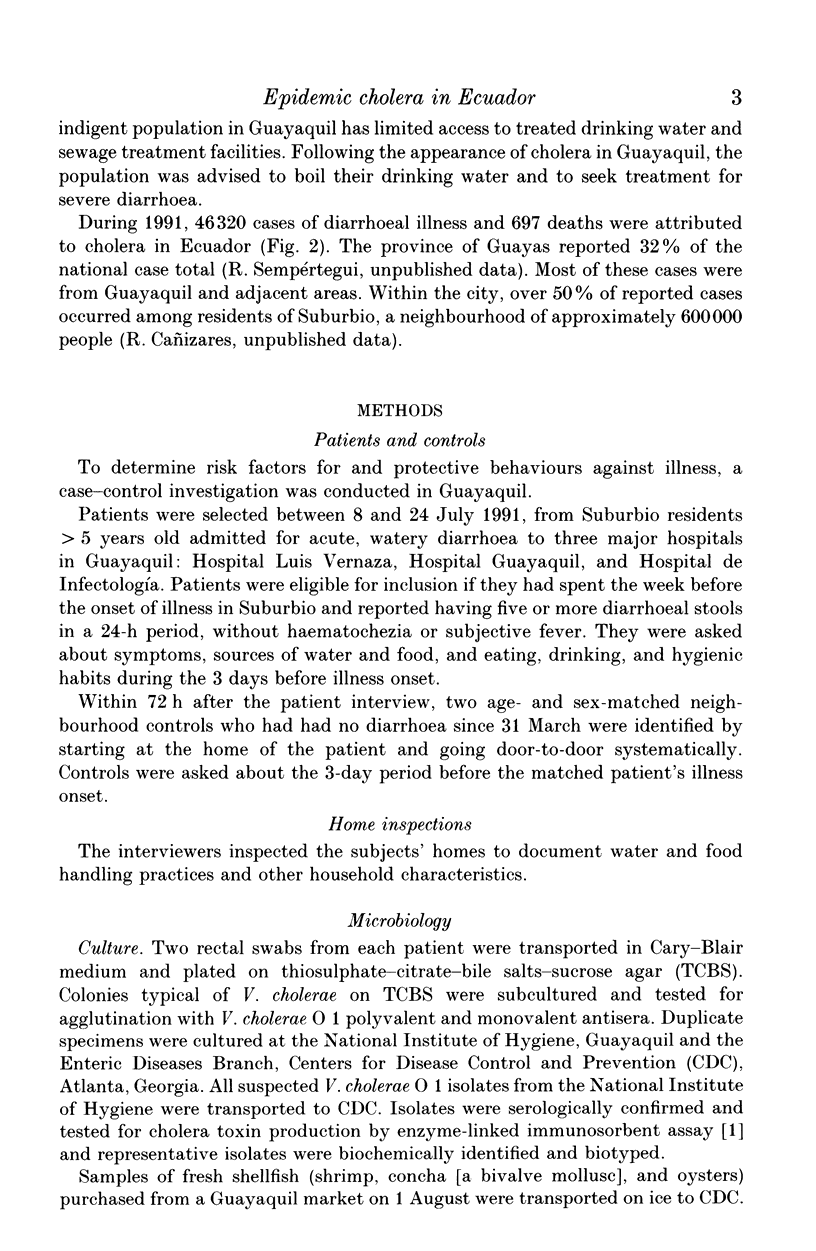
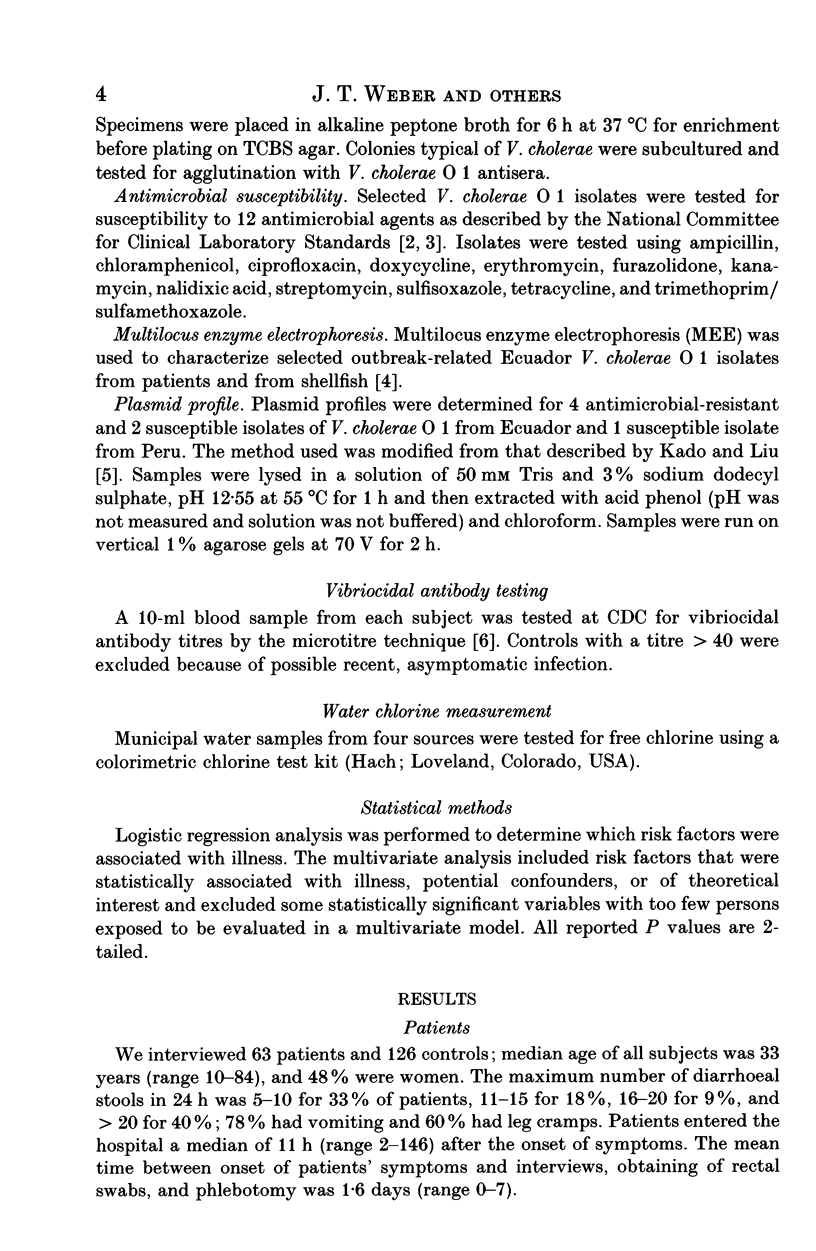
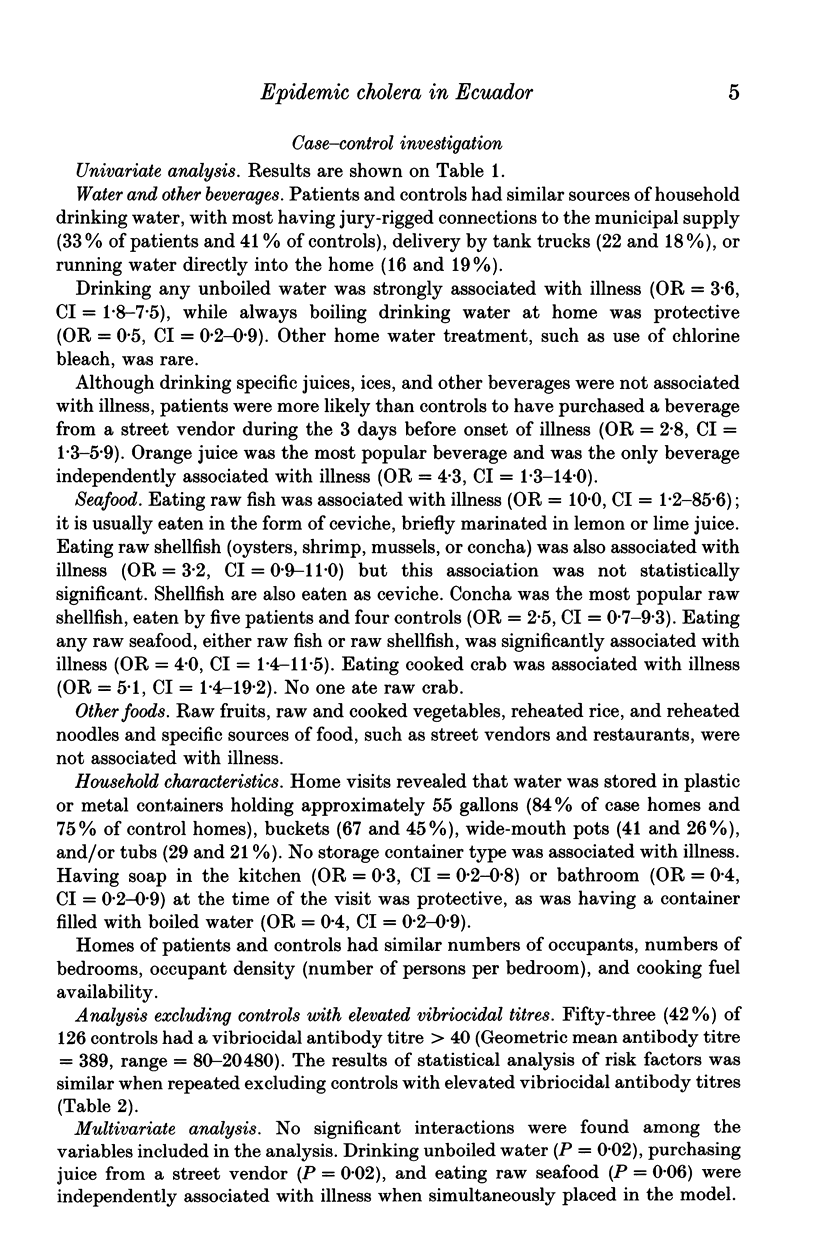
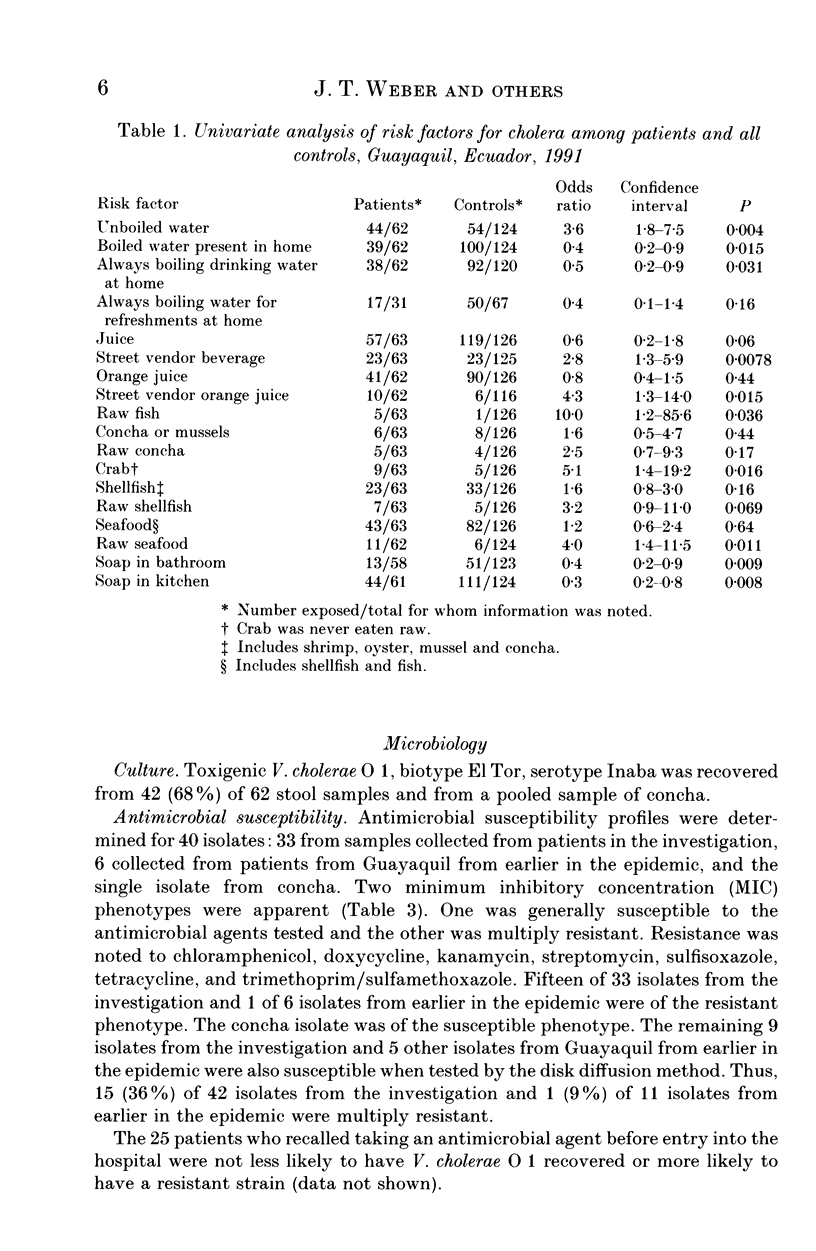
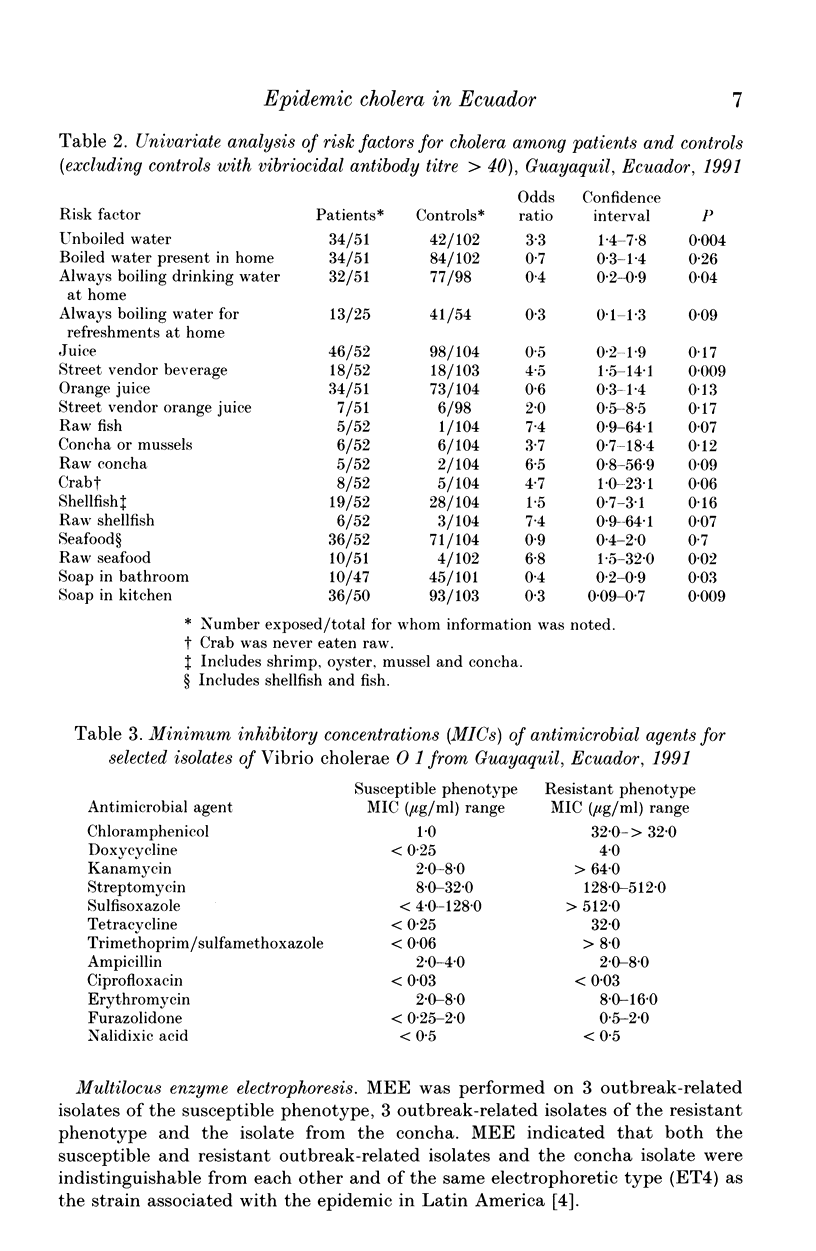
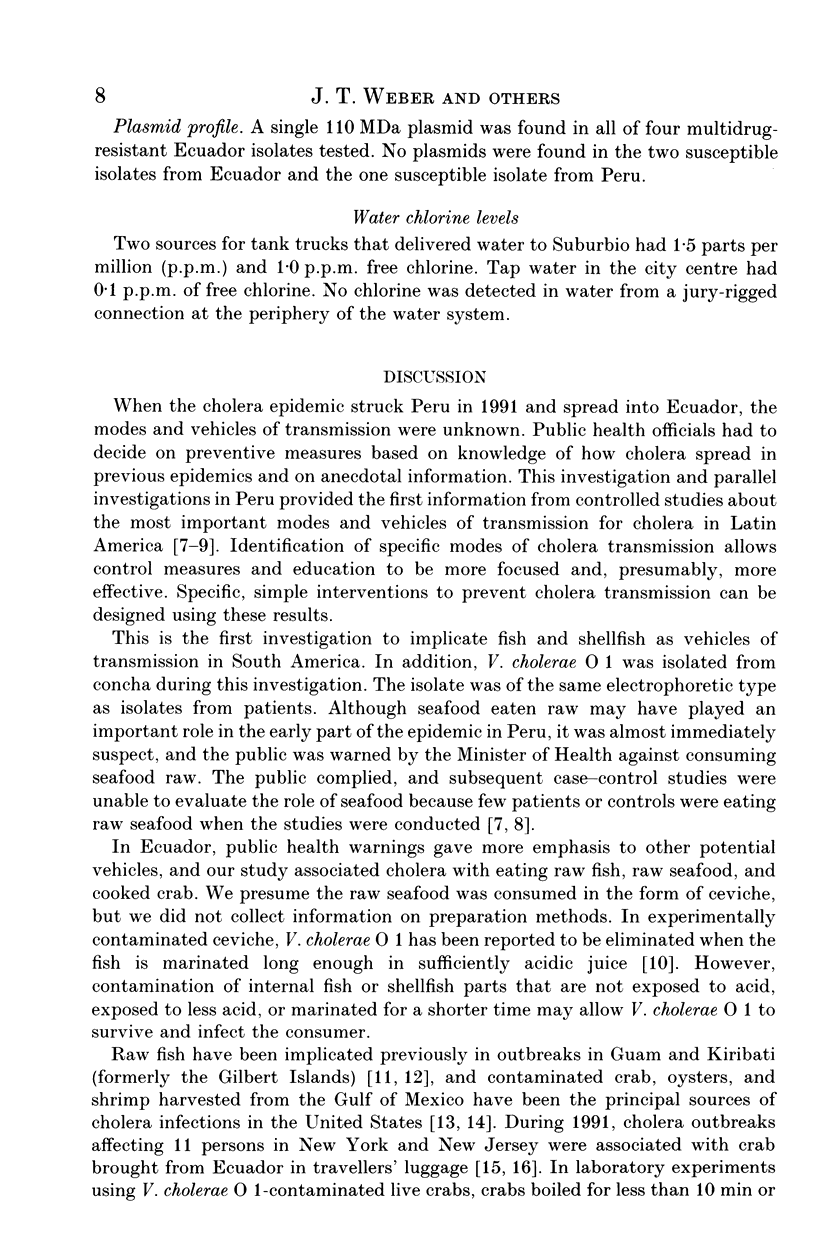
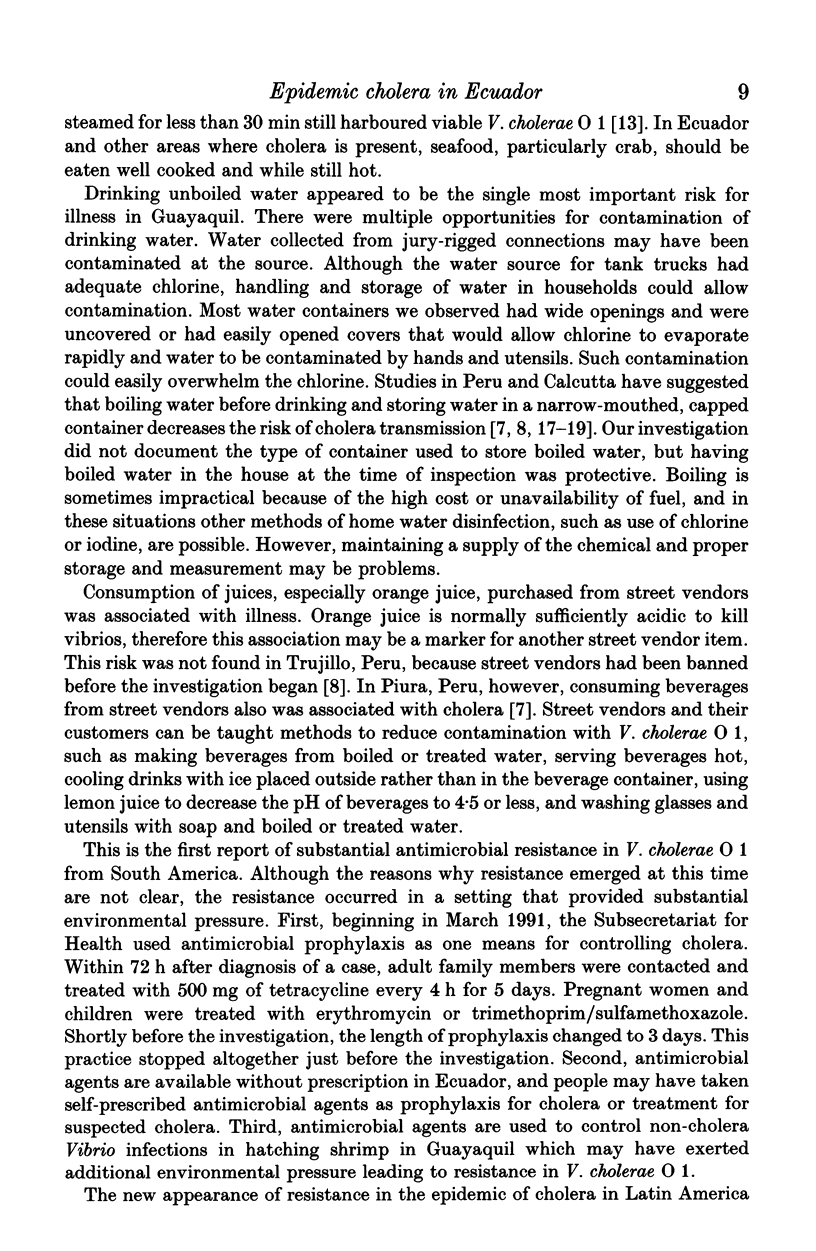
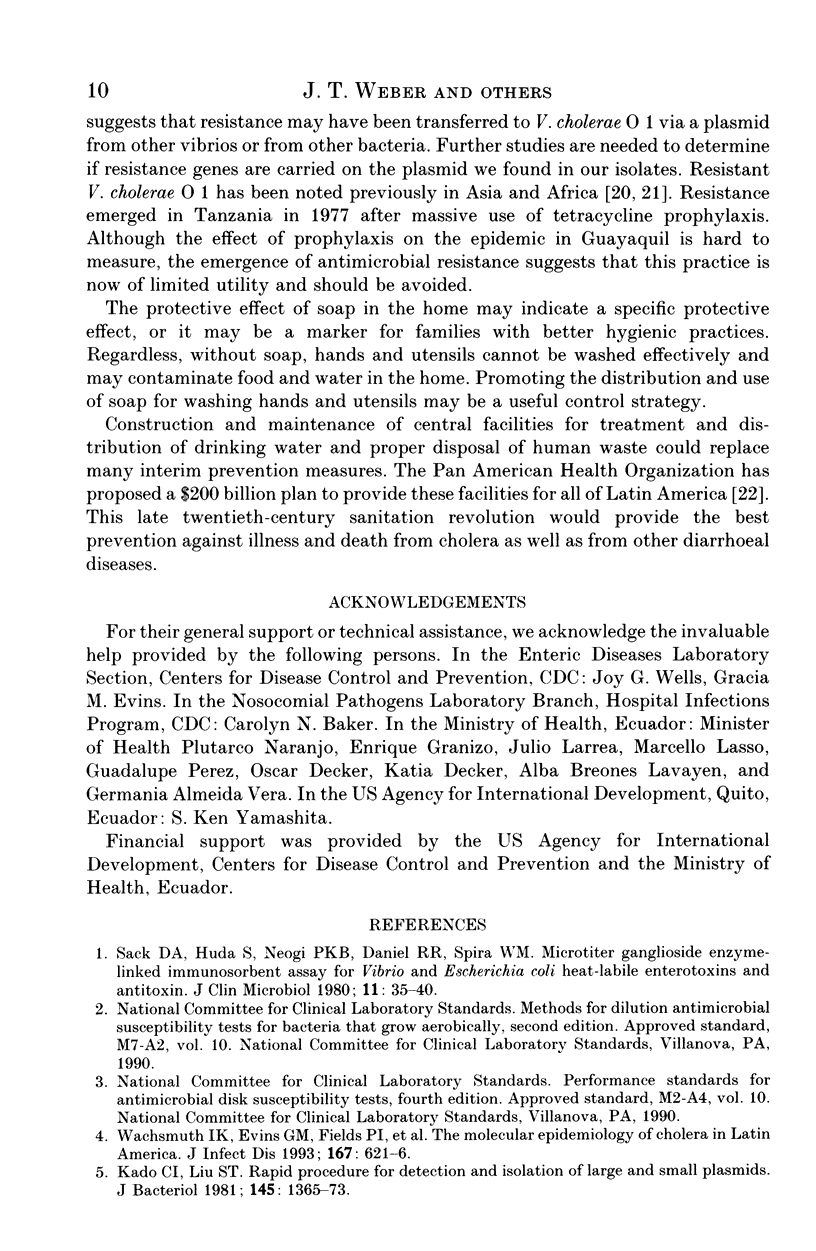
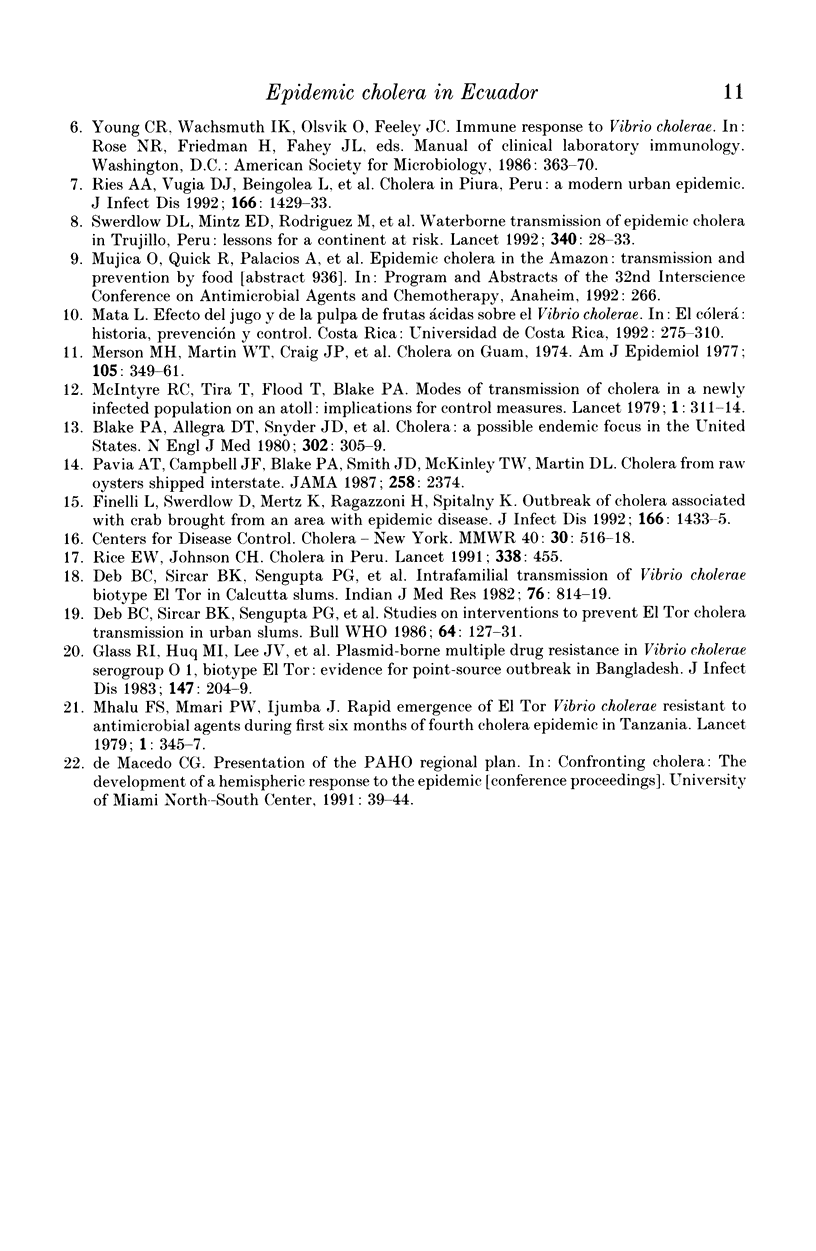
Selected References
These references are in PubMed. This may not be the complete list of references from this article.
- Blake P. A., Allegra D. T., Snyder J. D., Barrett T. J., McFarland L., Caraway C. T., Feeley J. C., Craig J. P., Lee J. V., Puhr N. D. Cholera--a possible endemic focus in the United States. N Engl J Med. 1980 Feb 7;302(6):305–309. doi: 10.1056/NEJM198002073020601. [DOI] [PubMed] [Google Scholar]
- Deb B. C., Sircar B. K., Sengupta P. G., De S. P., Mondal S. K., Gupta D. N., Saha N. C., Ghosh S., Mitra U., Pal S. C. Studies on interventions to prevent eltor cholera transmission in urban slums. Bull World Health Organ. 1986;64(1):127–131. [PMC free article] [PubMed] [Google Scholar]
- Deb B. C., Sircar B. K., Sengupta P. G., De S. P., Sen D., Saha M. R., Pal S. C. Intra-familial transmission of Vibrio cholerae biotype E1 Tor in Calcutta slums. Indian J Med Res. 1982 Dec;76:814–819. [PubMed] [Google Scholar]
- Finelli L., Swerdlow D., Mertz K., Ragazzoni H., Spitalny K. Outbreak of cholera associated with crab brought from an area with epidemic disease. J Infect Dis. 1992 Dec;166(6):1433–1435. doi: 10.1093/infdis/166.6.1433. [DOI] [PubMed] [Google Scholar]
- Glass R. I., Huq M. I., Lee J. V., Threlfall E. J., Khan M. R., Alim A. R., Rowe B., Gross R. J. Plasmid-borne multiple drug resistance in Vibrio cholerae serogroup O1, biotype El Tor: evidence for a point-source outbreak in Bangladesh. J Infect Dis. 1983 Feb;147(2):204–209. doi: 10.1093/infdis/147.2.204. [DOI] [PubMed] [Google Scholar]
- Kado C. I., Liu S. T. Rapid procedure for detection and isolation of large and small plasmids. J Bacteriol. 1981 Mar;145(3):1365–1373. doi: 10.1128/jb.145.3.1365-1373.1981. [DOI] [PMC free article] [PubMed] [Google Scholar]
- McIntyre R. C., Tira T., Flood T., Blake P. A. Modes of transmission of cholera in a newly infected population on an atoll: implications for control measures. Lancet. 1979 Feb 10;1(8111):311–314. doi: 10.1016/s0140-6736(79)90719-0. [DOI] [PubMed] [Google Scholar]
- Merson M. H., Martin W. T., Craig J. P., Morris G. K., Blake P. A., Craun G. F., Feeley J. C., Camacho J. C., Gangarosa E. J. Cholera on Guam, 1974: epidemiologic findings and isolation of non-toxinogenic strains. Am J Epidemiol. 1977 Apr;105(4):349–361. doi: 10.1093/oxfordjournals.aje.a112393. [DOI] [PubMed] [Google Scholar]
- Mhalu F. S., Mmari P. W., Ijumba J. Rapid emergence of El Tor Vibrio cholerae resistant to antimicrobial agents during first six months of fourth cholera epidemic in Tanzania. Lancet. 1979 Feb 17;1(8112):345–347. doi: 10.1016/s0140-6736(79)92889-7. [DOI] [PubMed] [Google Scholar]
- Pavia A. T., Campbell J. F., Blake P. A., Smith J. D., McKinley T. W., Martin D. L. Cholera from raw oysters shipped interstate. JAMA. 1987 Nov 6;258(17):2374–2374. [PubMed] [Google Scholar]
- Rice E. W., Johnson C. H. Cholera in Peru. Lancet. 1991 Aug 17;338(8764):455–455. doi: 10.1016/0140-6736(91)91086-a. [DOI] [PubMed] [Google Scholar]
- Ries A. A., Vugia D. J., Beingolea L., Palacios A. M., Vasquez E., Wells J. G., Garcia Baca N., Swerdlow D. L., Pollack M., Bean N. H. Cholera in Piura, Peru: a modern urban epidemic. J Infect Dis. 1992 Dec;166(6):1429–1433. doi: 10.1093/infdis/166.6.1429. [DOI] [PubMed] [Google Scholar]
- Sack D. A., Huda S., Neogi P. K., Daniel R. R., Spira W. M. Microtiter ganglioside enzyme-linked immunosorbent assay for vibrio and Escherichia coli heat-labile enterotoxins and antitoxin. J Clin Microbiol. 1980 Jan;11(1):35–40. doi: 10.1128/jcm.11.1.35-40.1980. [DOI] [PMC free article] [PubMed] [Google Scholar]
- Swerdlow D. L., Mintz E. D., Rodriguez M., Tejada E., Ocampo C., Espejo L., Greene K. D., Saldana W., Seminario L., Tauxe R. V. Waterborne transmission of epidemic cholera in Trujillo, Peru: lessons for a continent at risk. Lancet. 1992 Jul 4;340(8810):28–33. doi: 10.1016/0140-6736(92)92432-f. [DOI] [PubMed] [Google Scholar]
- Wachsmuth I. K., Evins G. M., Fields P. I., Olsvik O., Popovic T., Bopp C. A., Wells J. G., Carrillo C., Blake P. A. The molecular epidemiology of cholera in Latin America. J Infect Dis. 1993 Mar;167(3):621–626. doi: 10.1093/infdis/167.3.621. [DOI] [PubMed] [Google Scholar]


